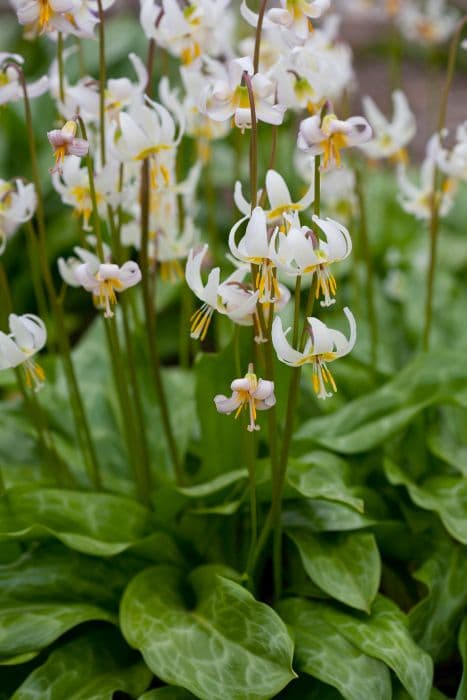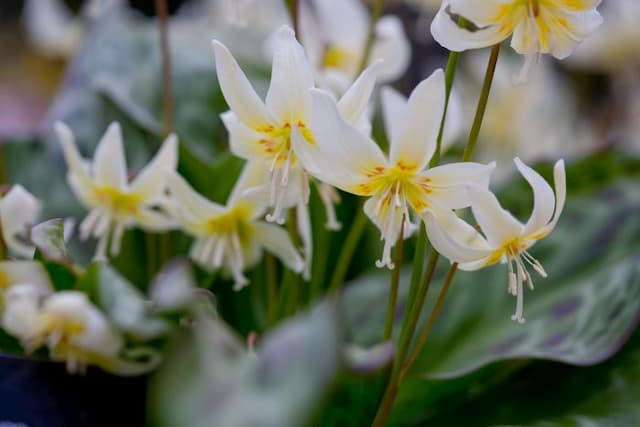Martagon Lily Lilium 'Arabian Knight' (Iic/d)

ABOUT
The Lilium 'Aribbean Knight' (Iic/d), also known as the Martagon hybrid lily, is a captivating flowering plant known for its unique and striking flowers. The petals of this lily are beautifully recurved—that is, they curl backward toward the stem—displaying an elegant turk's cap shape. This distinctive characteristic lends an old-world charm to the flower. The Martagon hybrid lily features a deep, velvety maroon or burgundy color, often with speckles or spots in a lighter hue, which can sometimes be golden or yellow-orange, sprinkled across the petals. These spots enhance the exotic appeal of the plant, adding depth and intricacy to the overall appearance. The contrast between the dark, luscious floral color and the speckles creates a stunning visual that is very appealing in garden settings. Surrounding the central part of the flower, the filaments holding the pollen are typically a contrasting color, further enriching the visual interest of each bloom. The stamens are prominently displayed, with anthers that carry pollen, and may offer a touch of brightness with their color contrast against the darker petals. The foliage of the lily is an attractive green, providing a lush backdrop for the dramatic flowers. The leaves are usually narrow and lance-shaped, arranged in whorls around the stem, contributing to the plant's overall elegance. In summary, the Martagon hybrid lily 'Arabian Knight' is a visually striking plant that boasts recurved, maroon or burgundy petals with enchanting spots, set off by distinctive stamens and lush, green foliage. Its exotic appearance brings a touch of sophistication to any garden.
About this plant
 Names
NamesFamily
Liliaceae
Synonyms
Arabian Knight Lily
Common names
Lilium 'Arabian Knight' (Iic/d).
 Toxicity
ToxicityTo humans
The Lilium 'Arabian Knight,' commonly known as a type of lily, can be toxic to humans if ingested. Lily plants contain compounds that can cause symptoms of gastrointestinal discomfort, such as nausea, vomiting, abdominal pain, and diarrhea, if any part of the plant is consumed. In addition to gastrointestinal symptoms, there may be a risk of dehydration or electrolyte imbalances as a result of these symptoms. Eating significant quantities of the plant can lead to more severe toxicity, potentially affecting the kidneys or causing cardiac issues. It is always important to handle lilies with care and ensure they are not ingested by children or adults.
To pets
For pets, the Lilium 'Arabian Knight', or simply lily, poses a significant risk, especially to cats. All parts of a lily plant are highly toxic to cats and can lead to life-threatening kidney failure. Symptoms of lily poisoning in pets may include vomiting, lethargy, lack of appetite, and increased or decreased urination. Immediate veterinary attention is crucial if a pet ingests any part of a lily plant. Early intervention is key to the successful treatment and recovery of an affected pet. Dogs may experience mild gastrointestinal upset if they ingest lilies, but the toxicity is much more severe in cats. Pet owners should prevent their pets, particularly cats, from accessing any part of a lily plant.
 Characteristics
CharacteristicsLife cycle
Perennials
Foliage type
Deciduous
Color of leaves
Green
Flower color
Red
Height
4 feet (1.22 meters)
Spread
1 foot (0.3 meters)
Plant type
Bulb
Hardiness zones
4
Native area
Asia
Benefits
 General Benefits
General Benefits- Attractive Flowers: The 'Arabian Knight' lily, with its striking flowers, adds visual interest to gardens and landscapes.
- Garden Design: Often used in borders, beds, and as a focal point due to its height and color, it provides structure to garden design.
- Pollinator Attraction: The vibrant blossoms attract bees, butterflies, and other pollinators, supporting local ecosystems.
- Cut Flowers: Long-lasting and fragrant, the blooms are ideal for cutting and creating indoor floral arrangements.
- Ease of Care: As a hardy perennial, it requires minimal maintenance once established, making it suitable for many gardeners.
- Diverse Planting Options: It can thrive in a variety of soil types and can be planted in full sun to partial shade, offering flexibility in garden placement.
- Seasonal Interest: Blooming in the summer, it provides seasonal interest when many other plants may not be flowering.
- Height Variation: Its stature allows it to be a background plant in garden compositions, complementing lower-growing flowers.
- Cultural Significance: Lilies are often associated with cultural and religious symbolism, which may add significance to a garden for some individuals.
 Medical Properties
Medical PropertiesThis plant is not used for medical purposes.
 Air-purifying Qualities
Air-purifying QualitiesThis plant is not specifically known for air purifying qualities.
 Other Uses
Other Uses- Lilies can be used as a natural dye source. The petals of the 'Arabian Knight' lily can provide shades of yellow, orange, or brown when used for fabric dyeing.
- In art and photography, the striking appearance of the 'Arabian Knight' lily can serve as a muse for artists and photographers looking for inspiration or a beautiful subject matter.
- The 'Arabian Knight' lily petals can be pressed and preserved in glass frames or used in crafts such as resin jewelry, providing a way to enjoy their beauty long after the blooming season.
- As a natural pest deterrent in gardens, the strong fragrance of lilies can help repel certain insects, protecting other plants grown nearby.
- In culinary presentations, the vibrant petals can be used as an eye-catching garnish for desserts and exotic dishes, though they should not be consumed unless specifically deemed edible.
- In floristry, beyond traditional arrangements, 'Arabian Knight' lilies can be used in creative installations and avant-garde floral designs for events and showcases.
- The petals of the lily can be used in paper-making, contributing color and texture to handmade papers for a unique touch.
- In perfumery, while not typically extracted for scent, the fragrance of lilies can inspire perfumers to create scents that evoke the essence of the 'Arabian Knight' lily.
- During festive celebrations, lilies can be used to decorate floats or venues, adding natural elegance and vibrant color to the ambiance.
- The lily's large petals can serve as natural palettes for children's finger painting activities, allowing them to explore the textures and colors of live plants.
Interesting Facts
 Feng Shui
Feng ShuiThe Lily is not used in Feng Shui practice.
 Zodiac Sign Compitability
Zodiac Sign CompitabilityThe Lily is not used in astrology practice.
 Plant Symbolism
Plant Symbolism- Purity - The lily is widely recognized as a symbol of purity, especially in Christian contexts where it is often associated with the Virgin Mary.
- Passion - The 'Arabian Knight' cultivar, with its bold colors, can symbolize intense passion and enthusiasm.
- Renewal and Rebirth - Lilies often bloom in the spring, coming back year after year, representing new beginnings and the renewal of life.
- Royalty - With their majestic appearance, lilies are often associated with regal splendor and the dignity of kings.
- Motherhood and Fertility - Lilies can represent motherhood, fertility, and the concept of fecundity because of their full, rounded blooms.
- Transitions - The flower's life cycle is seen as a metaphor for the transitions in life, such as from one phase to another, or from life to death.
 Water
WaterThe Arabian Knight lily should be watered thoroughly when the top inch of soil feels dry to the touch, avoiding overly soggy soil as it can lead to bulb rot. In general, this might translate to watering every week, but this can vary greatly depending on climate and weather conditions such as heat and wind which increase evapotranspiration. It's crucial to provide enough water to reach the roots at a depth of about 6-8 inches, which could be about 1-2 gallons depending on pot size and outdoor conditions. Decrease watering in the late fall as the plant goes dormant, and resume regular watering when new growth appears in the spring.
 Light
LightArabian Knight lilies thrive in full sun to partial shade conditions. They perform best when they receive at least six hours of direct sunlight each day. An ideal spot would be one that gets morning sun and some afternoon shade, especially in hotter climates where intense afternoon sun can be too harsh. Avoid deep shade locations as this will reduce the amount of blooms the plant produces.
 Temperature
TemperatureArabian Knight lilies prefer moderate temperatures and will grow best when daytime temperatures are between 60°F and 75°F. They can survive minimum temperatures down to about -20°F, but should be protected with mulch in colder zones to prevent the bulbs from freezing. The ideal growing conditions include nights that are cool and days that are not excessively hot, as extreme heat can stress the plants.
 Pruning
PruningPruning Arabian Knight lilies is mainly done to remove spent flowers and any damaged or diseased foliage, which encourages reblooming and maintains plant health. Deadheading, or cutting off the old blooms, should be done as soon as the flowers fade. Cut back the stems to the base of the plant once they have completely died back in the fall. Once a year pruning after blooming and seasonal cutback are generally sufficient.
 Cleaning
CleaningAs needed
 Soil
SoilThe best soil mix for Arabian Knight Lily (Martagon Lily) should be well-draining with a mix of loam, sand, and organic matter like peat or compost. Ideal soil pH for this lily is slightly acidic to neutral, ranging from 6.0 to 7.0.
 Repotting
RepottingMartagon Lilies, such as the Arabian Knight variety, typically do not need frequent repotting and can be left undisturbed for several years. It's generally recommended to repot or divide these lilies every 3 to 5 years to maintain vigor and prevent overcrowding.
 Humidity & Misting
Humidity & MistingArabian Knight Lilies (Martagon Lilies) prefer moderate ambient humidity and will thrive best when provided with conditions that avoid excessively dry air which can be common indoors, particularly during winter months.
 Suitable locations
Suitable locationsIndoor
Place in bright, indirect light and ensure good air circulation.
Outdoor
Choose a spot with partial shade and well-draining soil.
Hardiness zone
3-9 USDA
 Life cycle
Life cycleThe life of Lilium 'Arabian Knight', commonly known as the Martagon Lily, begins with the germination of its bulb, which requires a period of winter chilling to break dormancy. After chilling, in spring, the bulb sends up a stem with whorled leaves, and the plant enters a vegetative growth stage. During late spring to early summer, the stem elongates and produces an inflorescence with several downward-facing, Turk's cap-style flowers, which can be pollinated by insects like bees and butterflies. Following pollination, the flowers develop into seed capsules that mature through the summer. Once ripe, these capsules split open to release seeds that can be dispersed by wind or gravity. Perennial by nature, the plant then goes dormant in the fall, with the bulb surviving underground through the winter to begin the cycle anew the following spring.
 Propogation
PropogationPropogation time
Late summer to autumn
The Lilium 'Arabian Knight', commonly known as the Tiger Lily, is best propagated through division of its bulbs, which is typically done in late fall after the foliage has died back or in early spring before growth resumes. To propagate by division, carefully dig up the entire plant and gently separate the small bulblets from the main bulb. These bulblets, which are essentially clones of the mother plant, should be replanted immediately at a depth of about 4 to 6 inches (10 to 15 centimeters) and spaced 8 to 10 inches (20 to 25 centimeters) apart in well-draining soil. Water the newly planted bulblets thoroughly to help establish them. This method is favored for its simplicity and effectiveness in expanding your lily collection.








